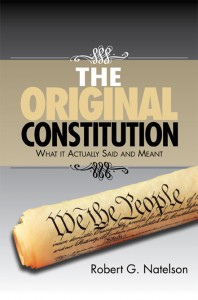It is often said that the Constitution should be interpreted according to its “original intent, “original understanding,” or “original meaning.” Is there any difference between these concepts? And if so, which is the proper standard?
This is an area in which there has been a great deal of confusion, largely because few constitutional writers are familiar with how 18th-century lawyers and judges construed documents.
We can begin clearing the confusion by defining the terms. The phrase original intent usually means the subjective opinion of those who wrote the Constitution as to what a particular provision was supposed to communicate. Original intent also is called the intent of the Framers. Researchers try to deduce the original intent by examining both direct evidence (what the 55 drafters said during the Constitutional Convention), and indirect or circumstantial evidence. Examples of the latter include, among other things, what people said about the instrument during the ratification debates, the meaning of key words in common discourse and in contemporaneous dictionaries, and their meaning in legal and literary sources.
The original understanding of a constitutional provision usually refers to the subjective opinion of the 1648 state convention delegates who ratified the Constitution. Principal sources are the records of the ratifying debates. For example, if Delegate X explained a provision in the document in a particular way and no one contradicted him, then (particularly if Delegate X was a proponent) you can infer that other delegates understood the provision the same way. Indirect and circumstantial evidence for original understanding include what Framers and commentators said about the provision, as well as the meaning of the words in common discourse and in contemporaneous dictionaries and legal sources.
The original meaning (or original public meaning) is how a reasonably intelligent, involved member of the public would have interpreted a provision. Primary evidence of original meaning is how words were used in common discourse and the definitions in contemporaneous dictionaries and legal sources. Circumstantial evidence includes the drafting and ratification conventions, public debates, and so forth.
Obviously, the evidence used in prove each of the three concepts overlaps. In practice, moreover, the original intent of a provision is usually the same as the original understanding or original meaning.
But differences do occur. For example, during the 1787 drafting convention, John Dickinson stated, without contradiction, that ex post facto laws were always retroactive criminal laws, and did not include retroactive civil laws. (Examples of the latter are retroactive taxes and statutes to cure defective legal proceedings.) That, apparently, formed the Framers’ original intent. But during the ratification debates, it became clear that many, perhaps most, people thought that an ex post facto law might be civil as well as criminal (original meaning). So the ratifiers worked out a deal by which the term was understood include only criminal laws. This was the original understanding.
In the event of a conflict between intent, understanding and meaning, which should control?
The key to answering that question is to answer another: “When the Constitution was adopted, what was its legal force? In other words, how would the courts of the time have interpreted it?
The Constitution is, of course, a legal document, so you can find the correct response to this question by investigating how judges, and other lawyers and public officials interpreted legal documents of the same general kind during the Founding Era. In 2005, I spent much of a sabbatical at Oxford University researching this question. I learned the following:
* Most legal documents, including state constitutions, were interpreted according to the “intent of the makers” of the document.
* Just as a statute was interpreted by the intent of the legislators who gave it force rather than by the intent of the legislative staffers who wrote it, the Constitution was to be interpreted by the understanding of the ratifiers who gave it force rather than the intent of the Framers who wrote it.
* When judges and other lawyers referred to the “intent of the makers” they meant the genuine subjective intent. The subjective intent of the ratifiers is the same as original understanding.
* Where the original understanding was not recoverable, either because the evidence was lacking or hopeless contradictory, Founding-Era courts and lawyers applied the meaning a reasonable person would have given a term—that is, original meaning.
Thus, the original legal force of the Constitution—as it would have been applied by Founding-Era judges, lawyers, and officials—is based on the original understanding; if this is not recoverable, then you apply the original meaning. Original intent is useful only insofar as it tends to prove understanding or meaning.
More discussion on this topic appears in my book, The Original Constitution: What It Actually Said and Meant. Those who wish detailed citations and full scholarly discussion can read the article that emerged from my Oxford research: The Founders’ Hermeneutic: The Real Original Understanding of Original Intent.
- The Constitution and the Trump Tariffs - December 7, 2025
- Ancient Rome and the Constitution - October 29, 2025
- President Trump, the Constitution, and the National Guard Cases - October 22, 2025

